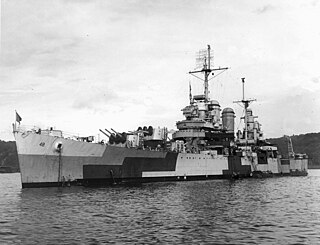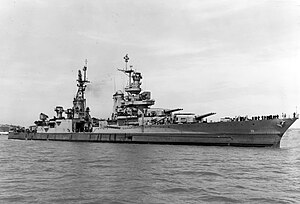
A cruiser is a type of warship. Modern cruisers are generally the largest ships in a fleet after aircraft carriers and amphibious assault ships, and can usually perform several roles.

A light cruiser is a type of small or medium-sized warship. The term is a shortening of the phrase "light armored cruiser", describing a small ship that carried armor in the same way as an armored cruiser: a protective belt and deck. Prior to this smaller cruisers had been of the protected cruiser model, possessing armored decks only. While lighter and smaller than other contemporary ships they were still true cruisers, retaining the extended radius of action and self-sufficiency to act independently around the world. Through their history they served in a variety of roles, primarily as convoy escorts and destroyer command ships, but also as scouts and fleet support vessels for battle fleets.

The heavy cruiser was a type of cruiser, a naval warship designed for long range and high speed, armed generally with naval guns of roughly 203 mm (8 inches) in caliber, whose design parameters were dictated by the Washington Naval Treaty of 1922 and the London Naval Treaty of 1930. The heavy cruiser is part of a lineage of ship design from 1915 through the early 1950s, although the term "heavy cruiser" only came into formal use in 1930. The heavy cruiser's immediate precursors were the light cruiser designs of the 1900s and 1910s, rather than the armored cruisers of the years before 1905. When the armored cruiser was supplanted by the battlecruiser, an intermediate ship type between this and the light cruiser was found to be needed—one larger and more powerful than the light cruisers of a potential enemy but not as large and expensive as the battlecruiser so as to be built in sufficient numbers to protect merchant ships and serve in a number of combat theaters.

The Northampton-class cruisers were a group of six heavy cruisers built for the United States Navy, and commissioned between 1928 and 1931.

The armored cruiser was a type of warship of the late 19th and early 20th centuries. It was designed like other types of cruisers to operate as a long-range, independent warship, capable of defeating any ship apart from a battleship and fast enough to outrun any battleship it encountered.

The New Orleans-class cruisers were a class of seven heavy cruisers built for the United States Navy (USN) in the 1930s.

Hiei (比叡) was a warship of the Imperial Japanese Navy during World War I and World War II. Designed by British naval architect George Thurston, she was the second launched of four Kongō-class battlecruisers, among the most heavily armed ships in any navy when built. Laid down in 1911 at the Yokosuka Naval Arsenal, Hiei was formally commissioned in 1914. She patrolled off the Chinese coast on several occasions during World War I, and helped with rescue efforts following the 1923 Great Kantō earthquake.

USS Portland (CL/CA–33) was the lead ship of the Portland class of cruiser and the first ship of the United States Navy named after the city of Portland, Maine. Launched in 1932, she completed a number of training and goodwill cruises in the interwar period before seeing extensive service during World War II, beginning with the Battle of the Coral Sea in 1942, where she escorted the aircraft carrier Yorktown and picked up survivors from the sunken carrier Lexington. She screened for Yorktown again in the Battle of Midway, picking up her survivors as well. She then supported the carrier Enterprise during the initial phase of the Guadalcanal Campaign later that year, and was torpedoed during the Naval Battle of Guadalcanal. The torpedo inflicted heavy damage which put her out of action for six months as she was repaired in Sydney, Australia, and later San Diego, California.

The Brooklyn-class cruiser was a class of nine light cruisers built for the United States Navy between 1935 and 1938. Armed with five triple 6 inches (152 mm) gun turrets, they mounted more main battery guns than any other standard US cruiser. The Brooklyn-class ships were all commissioned between 1937 and 1939, in the time between the start of the Second Sino-Japanese War and before the invasion of Poland. They served extensively in both the Pacific and Atlantic theaters during World War II.

Kongō was a warship of the Imperial Japanese Navy during World War I and World War II. She was the first battlecruiser of the Kongō class, among the most heavily armed ships in any navy when built. Her designer was the British naval engineer George Thurston, and she was laid down in 1911 at Barrow-in-Furness in Britain by Vickers Shipbuilding Company. Kongō was the last Japanese capital ship constructed outside Japan. She was formally commissioned in 1913, and patrolled off the Chinese coast during World War I.

Kirishima (霧島) was a warship of the Imperial Japanese Navy during World War I and World War II. Designed by British naval engineer George Thurston, she was the third launched of the four Kongō-class battlecruisers. Laid down in 1912 at the Mitsubishi Shipyards in Nagasaki, Kirishima was formally commissioned in 1915 on the same day as her sister ship, Haruna. Kirishima patrolled on occasion off the Chinese coast during World War I, and helped with rescue efforts following the 1923 Great Kantō earthquake.

The New York class was a pair of dreadnought battleships built for the United States Navy between 1911 and 1914. The two ships of the class, New York and Texas, saw extensive service beginning in the occupation of Veracruz, World War I, and World War II.

The four Agano-class cruisers were light cruisers operated by the Imperial Japanese Navy. All were named after Japanese rivers. Larger than previous Japanese light cruisers, the Agano-class vessels were fast, but with little protection, and were under-gunned for their size. They participated in numerous actions during World War II.

The Fusō-class battleships were a pair of dreadnought battleships built for the Imperial Japanese Navy (IJN) before World War I and completed during it. Both patrolled briefly off the coast of China before being placed in reserve at the war's end. In 1922 Yamashiro became the first battleship in the IJN to successfully launch aircraft.

The Tennessee-class cruisers were four armored cruisers built for the United States Navy between 1903 and 1906. Their main armament of four 10-inch (254 mm) guns in twin turrets was the heaviest carried by any American armored cruiser. Their armor was thinner than that of the six Pennsylvanias which immediately preceded them, a controversial but inevitable decision due to newly imposed congressional restraints on tonnage for armored cruisers and the need for them to be able to steam at 22 knots. However, the fact their armor covered a wider area of the ship than in the Pennsylvanias and their increased firepower caused them to be seen by the Navy as an improvement.

The Myōkō-class cruisers were a series of four heavy cruisers built for the Imperial Japanese Navy in the late 1920s. Three were lost during World War II.

The Tsukuba-class cruisers were a pair of large armored cruisers built for the Imperial Japanese Navy (IJN) in the first decade of the 20th century. Construction began during the Russo-Japanese War of 1904–05 and their design was influenced by the IJN's experiences during the war. The British development of the battlecruiser the year after Tsukuba was completed made her and her sister ship Ikoma obsolete, as they were slower and more weakly armed than the British, and later German, ships. Despite this, they were reclassified in 1912 as battlecruisers by the IJN.

The St. Louis-class cruisers were a class of three cruisers that served in the United States Navy at the beginning of the 20th century. Authorized in fiscal year 1901 by an Act of Congress of 7 June 1900 as part of the naval buildup touched off by the Spanish–American War, the St. Louis-class cruiser initially began as an improved Olympia. However, during the design phase, decisions were made that increased the size of the vessel from 6,000 long tons (6,100 t) to 9,700 long tons (9,900 t), including adding protection that resulted in the designation "semi-armored cruiser". This led to a larger power plant, and other decisions were made to try to increase speed and range, such as using smaller 6-inch (152 mm) guns instead of 8-inch (203 mm) guns, and adding coal capacity. The completed ship at 9,700 long tons was the same displacement as a full armored cruiser without the same armor. One reference describes the class as "among the earliest well-documented examples of creeping growth in warship design".

The Lexington-class battlecruisers were officially the only class of battlecruiser to ever be ordered by the United States Navy. While these six vessels were requested in 1911 as a reaction to the building by Japan of the Kongō class, the potential use for them in the U.S. Navy came from a series of studies by the Naval War College which stretched over several years and predated the existence of the first battlecruiser, HMS Invincible. The fact they were not approved by Congress at the time of their initial request was due to political, not military considerations.






















